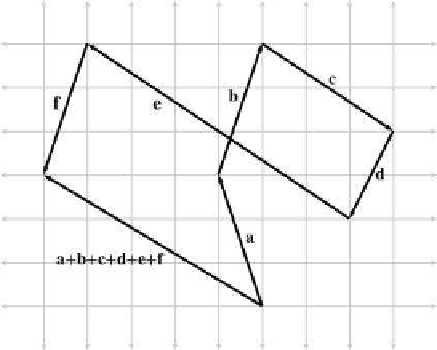Game Development Reference
In-Depth Information
the tail of
a
to the head of
b
. In other words, if we start at a point and
apply the displacements specified by
a
and then
b
, it's the same as if we
had applied the single displacement
a
+
b
. This is known as the triangle
rule of vector addition. It also works for vector subtraction, as shown in
Figure 2.10 provides geometric evidence that vector addition is commu-
tative but vector subtraction is not. Notice that the vector labeled
a
+
b
is
identical to the vector labeled
b
+
a
, but the vectors
d
−
c
and
c
−
d
point
in opposite directions because
d
−
c
= −(
c
−
d
).
Figure 2.11
Extending the triangle
rule to more than two
vectors
The triangle rule can be extended to more than two vectors. Figure 2.11
shows how the triangle rule verifies something we stated in
Section 2.3.1:
a
vector can be interpreted as a sequence of axially aligned displacements.
Figure 2.12
is a reproduction of
Figure 2.5,
which shows how the vector
[1,−3,4] may be interpreted as a displacement of 1 unit to the right, 3 units
down, and then 4 units forward, and can be verified mathematically by
using vector addition:
2
3
2
3
2
3
2
3
−3
4
1
0
0
−3
0
0
0
4
4
5
4
5
4
5
4
5
=
+
+
.
This seems obvious, but this is a very powerful concept. We will use a
similar technique in Section 4.2 to transform vectors from one coordinate
space to another.









Search WWH ::

Custom Search